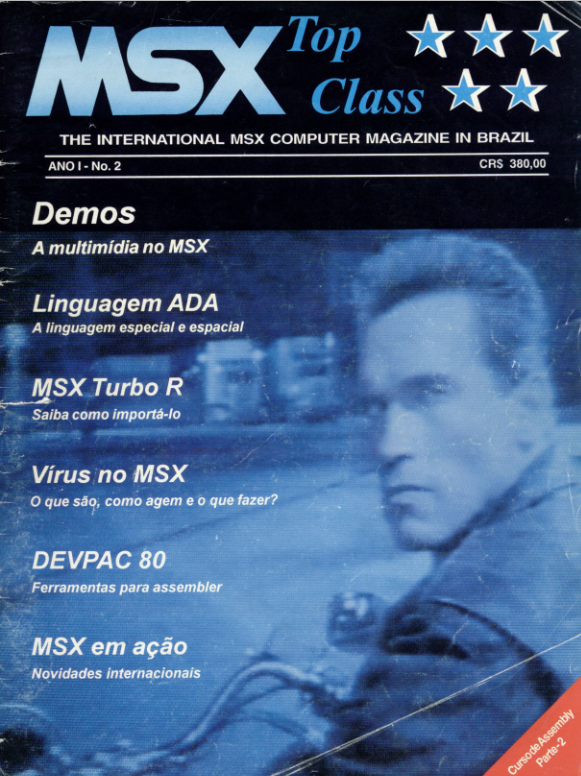Antstream Arcade Retro Gaming History: Video Games In Brazil
- graememason4
- Jun 7, 2024
- 4 min read
They say there’s no place like home. But when it comes to retro gaming and gaming history, there’s no place like Brazil. Graeme Mason delves into the South American country's official – and unofficial – videogames past.

It’s the largest economy in South America. It has the biggest population of the continent, over 200 million people, and is the fifth largest country in the world by land mass. It is, of course, Brazil, and the country has some unique gaming history to add to its other achievements. Welcome to an alternate world where SEGA has been solidly trumping Nintendo since the Eighties, and the prevalent 8-bit home computer was the MSX.

Games Consoles
Like most countries, Brazil’s love of home videogames began in the second half of the Seventies, primarily with the ubiquitous Pong machines. With imports from North America expensive and out of budget for most ordinary Brazilians, a company called Philco, originating from Philadelphia, US, and owned by car manufacturer Ford, created the Telejogo (TV Play) in 1977. This simple console contained just three built-in games: Football, Tennis, and Wall, all variations of the famous bat and ball concept. Despite the simplicity, Brazil lapped up the Telejogo enough for Philco to produce a sequel, Telejogo II, in 1979, complete with a ‘massive’ ten games.

Brazil lived under a military dictatorship for all of the Seventies and the first half of the Eighties. Among public expenditure cuts, the government made efforts to protect domestic Brazilian products, making foreign imports such as game consoles even more expensive – if you could find them, as they were officially prohibited under a law entitled Reserve Market. The dominant home console of the era – the Atari 2600 – thus began the trend of unofficial Brazilian clones. Local companies created their brands by replicating the Atari console's internal circuitry, most prominently the Dactar Video Game (and Dactar II), Dynacom Dynavision and the CCE Supergame VG-2800. This even resulted in Brazilian-exclusive or produced games, while other second-generation consoles also appeared in adopted Brazilian form, such as the Intellivision (Digiplay) and Colecovision (SpliceVision). Brazil's subsequent home console market was dominated by one company: the Nintendo-busting SEGA.

In 1987, Daniel Dazcal, VP of Sharp’s Brazilian operation, left the Japanese company to help form Tec Toy. Along with his partners, the German Kryss family, Dazcal had noticed an electronic toy gap in the Brazilian market and sought to exploit it, chiefly by officially licensing Sega’s Master System console. Like every other console, there were plenty of unofficial clones of the Master System’s rival elsewhere, the Nintendo Entertainment System. But from 1989, the SEGA console became official in Brazil and consequently secured a huge and dedicated following. The system was so popular that over 20 games were released exclusive to the region, including several Disney games and a port of Street Fighter 2, released in 1997.

Incredibly, the Master System remains commercially fashionable today in Brazil. Tec Toy’s latest version, the Master System Evolution, is still for sale on its website, priced at just R$360 (£55). Containing 132 games, including Sonic The Hedgehog, Shinobi and Altered Beast, it represents a nostalgic love for the SEGA console that time has not dimmed, and is a cost-effective alternative to expensive modern consoles.

Tec Toy has also maintained the Mega Drive line, releasing the Mega Drive 4 in 2009, complete with a Guitar Hero-style peripheral.
Home Computers
As mentioned above, the MSX was Brazil's standard bearer for home computers during the Eighties. Another Brazilian electronic company, Gradiente Eletrônica, produced the Expert Personal Computer, utilising the MSX Engine chip, in 1987, followed by the Expert DD Plus two years later. It even had bespoke magazines offering programming advice and hardware and software reviews – such as MSX Top Class – yet despite its widespread adoption, Gradiente terminated this MSX clone line shortly after the release of the second machine.

Of course, the Gradiente Expert wasn’t the only 8-bit computer in Brazil during the Eighties. There were also clones for the Sinclair ZX Spectrum (the TK 95 from Microdigital Eletrônica) and the ZX80 and ZX81 from the same company. In fact, Microdigital had a production line of clones, consisting of the TK2000 (Apple II) and the Onyx Jr, a replica of the Atari 2600 console, released after the company had abandoned its plans for a Colecovision clone (the original Onyx).

The Spirit Of Brazilian Gaming
Forged through necessity thanks to its political status during the Seventies and Eighties, Brazil is a unique creative force in gaming, from the special place SEGA holds in the hearts of millions of gamers to the dominance of mobile gaming today. In Brazil, a strong cultural empathy and passion for technology and the entertainment it can bring drives this.
The nostalgic boom of the SEGA Master System is kept alive in Brazil by the prohibitive price of imported consoles such as the PlayStation 4 due to taxation. It’s resulted in a thriving bootleg scene, with millions of games illegally ripped and repackaged for its local market. In this respect, the advent of the original Sony PlayStation and its fellow CD-ROM formats was a boon – now, games could be easily ripped and copied by anyone with a CD burner.

In the world of retro gaming, while it has today diversified into consumer electronics as wide as laptops, gaming mice and baby monitors, Tec Toy is keeping the SEGA flame alive, producing official consoles well after SEGA itself abandoned the technology. It’s crystal clear that, like Antstream Arcade, Brazil loves retro gaming.
To keep up to date with all things Antstream Arcade, check us out on Discord: https://discord.com/invite/antstream, Facebook https://www.facebook.com/AntstreamArcade and X (formerly Twitter) @AntstreamArcade.




Comments